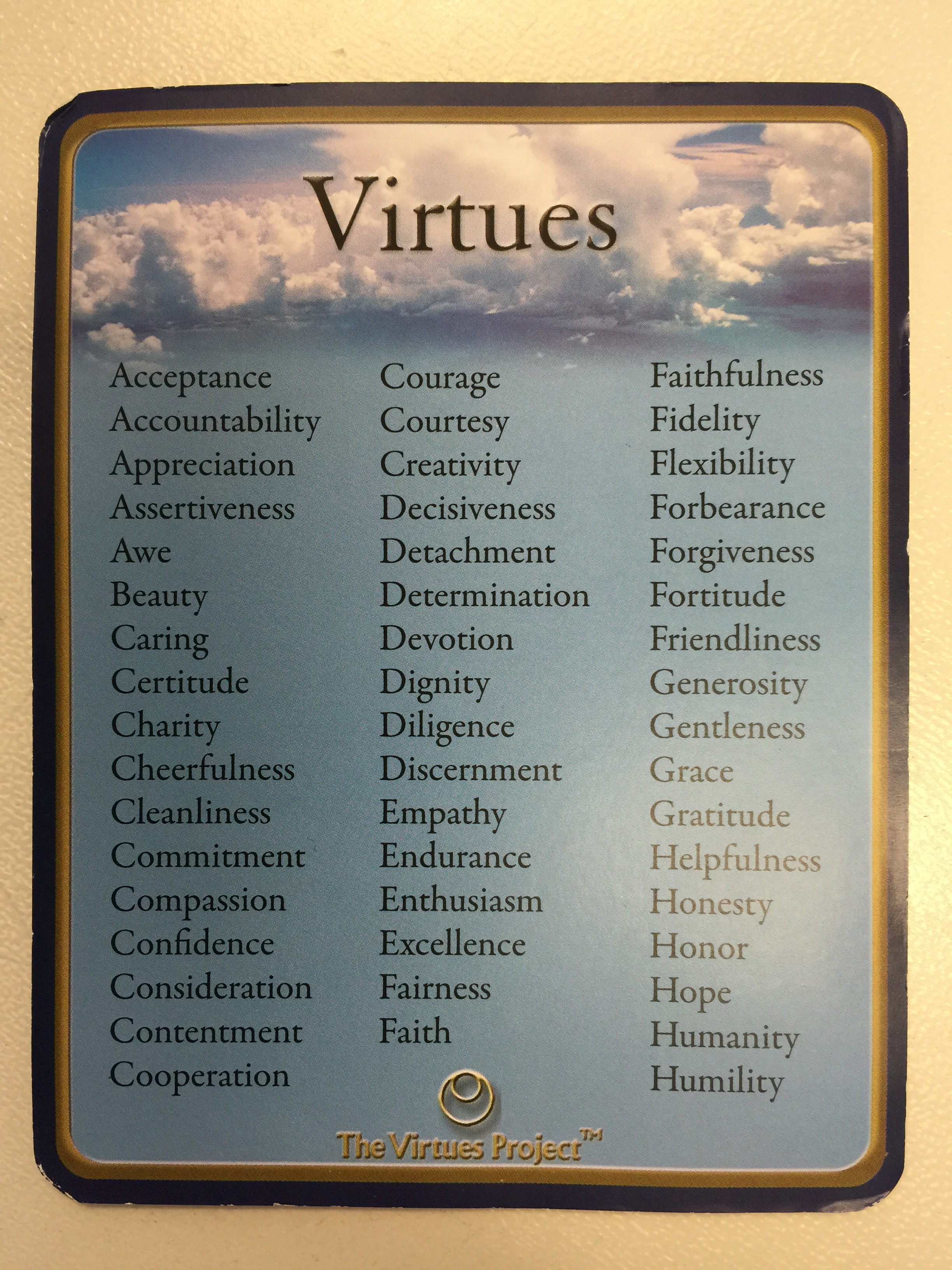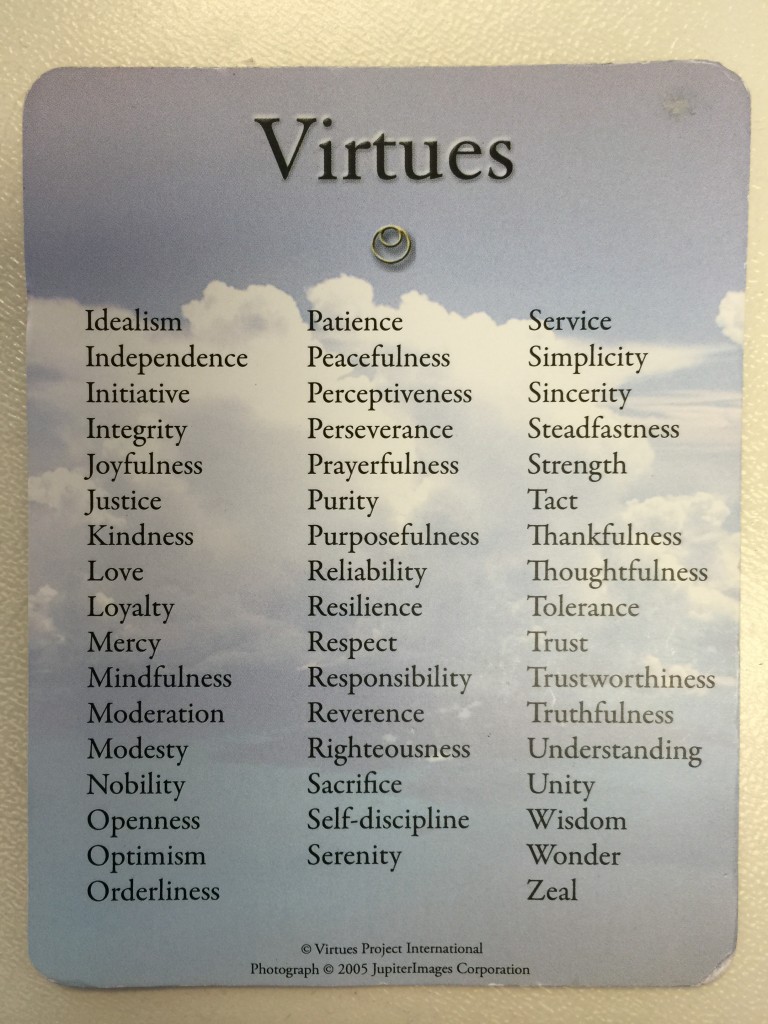#1 of the Five Strategies of The Virtues Project details click here
1. Speak the Language of the Virtues
Language has the power to inspire or to discourage. using virtues to acknowledge, guide, correct and thank awakens the best within us.
What are your strength virtues? What are your growth virtues?
Core Values (Character) & Virtues–are they the same thing? Yes, in that they are woven into the same “fabric of character.”
As I recently took a course at the Anne Arundel Community College’s TEACH Institute and Parenting Center–Introduction to the Virtues Project–now, with a better understanding of what the Virtues Project is, and how it aligns with The JNP Project, I am beginning to reference all this as a term I like to call the “fabric of character.” Core values are which The JNP Project’s adventure book series, Jane & Jake’s Adventures to Awesome (and all supporting empowerment tools) focuses on: Truth, Kindness, Harmony, Forgiveness, Giving, Love, Determination, Compassion, Strength, and Character, and The Virtues Project complements all this SEL (Social Emotional Learning) beautifully.
The JNP Project focuses on core values, which together, make up our individual character. Our “Me!” In the White Paper, Virtue Ethics without Character Traits, by Gilbert Harman, Princeton University, 8/18/99, he states, “In one version of virtue ethics, moral virtues are robust character traits possessed by ideally morally virtuous people. The character traits in question are acquired robust habits of perception, motivation and action: habits of perceiving situations in certain ways, habits of being motivated to act in certain ways, and habits of actually acting in those ways. In this view, to specify a moral virtue is to specify the relevant perceptual, motivational, and behavioral habits.” Summing up to character.
In the Character Traits Chart, by Character-in-Action® (image below) notes that “virtue” is one of their listed character traits. Character-in-Action defines the virtue trait as: Virtue = begins by comprehending that there is a clear, absolute standard of right and wrong, and then acts to bring every area of life into conformity to that absolute standard. And, The Virtues Project’s mission is “recognizing the gifts within.”
In conclusion, I wanted to state that our character, the essence of who we believe we are, in which we draw our strengths and values from (our own inner-awesome super-powers), is in essence our fabric of character–made up of core values and virtues. That is why it is so important to me to take note of our virtues and be advised by our virtues facilitators as we continue to create content for JNP.
#1 of the Five Strategies of The Virtues Project details click here
1. Speak the Language of the Virtues
Language has the power to inspire or to discourage. using virtues to acknowledge, guide, correct and thank awakens the best within us.
What are your strength virtues? What are your growth virtues?

NOTE: This series is written as a GUEST BLOG by our own JNP Advisory Committee Member, Ms. Biteena Frazier — now, our JNP Ambassador to the Middle East. She is a Master Solution-Focused Practitioner, PCI Certified Parent Coach and Virtues Project Facilitator. She has left the USA to pursue an interesting opportunity to help develop a behavior management and character development program for a new international school in the Middle East.
SPEAK THE LANGUAGE OF THE VIRTUES
This strategy is about developing the vocabulary of The Virtues. It is about teaching the words themselves so that children understand these concepts. Language defines what we consider important. To a large extent, language defines reality. If you do not have a word for something, it most likely does not exist in your conscious awareness. Only when we name something do we truly validate it as something real and significant. If you have ever studied a foreign language you know the experience of discovering that some people in this world place high value on something you never knew existed. For example, in some languages every family relationship has a different name. It makes a difference if your cousin is on your father’s side or on your mother’s side. In English, a cousin is a cousin and in some languages people who are not related by blood are still called cousins (signifying a valuation of the relationship). When a child is learning a language, they are learning all the values, customs and beliefs expressed in that language. This is why developing the Language of The Virtues is vitally important. When a child learns words like “gentleness” or “flexibility” or “respect” they are learning that these are ideas that are important in our society.
The Virtues Project has helpfully outlined three ways in which we can teach children on a daily basis the language of the virtues. Parents and teachers can do this by acknowledging, guiding and correcting.
Acknowledging is about letting children know when we see them practicing a particular virtue. Normally, we pay attention to children when they are not showing their virtues but it is important to let children know when you see the goodness in them. This is encouraging to a child and an effective way of growing their virtues. Positive reinforcement has been proven to be more powerful than negative reinforcement, so when we acknowledge positive qualities in children – their helpfulness, thoughtfulness, cooperation – we increase the likelihood that they will continue to show this quality.
Guiding is about letting a child know before something goes wrong the quality that you expect them to show. It is about setting a boundary of expectation, so that the child knows that they have a particular virtue – patience, peacefulness, courtesy – and that now is the time to show it. Children need reminding because they are just learning how to be in the world and just like when children learn to tie their shoes, they need to repeat the lesson again and again until they do it automatically
Repetition will also be needed when correcting a child. To use the Language of the Virtues, correcting requires that you comment on the missing virtue (rather than the negative behavior). So, for example, when a child has an untidy room, rather than use words like “lazy, sloppy, messy,” it is more effective to remind the child to use his or her “self-discipline, cleanliness, orderliness.” Giving a positive correction is not easy because it happens in a moment of distress when we are more likely to react instead of respond to the situation at hand. To call a child to his or her missing virtue requires large amounts of Detachment (not detachment from the child but from one’s own emotions) and Self-Discipline (to practice breathing through an emotion rather than immediately reacting). This is not easy and parents also need to practice Forgiveness for themselves when they do lose their temper. Speaking the Language of the Virtues is not a black and white skill, it is something that one can spend a lifetime working on, always striving to improve. Remember, there is no such thing as a perfect parent or child and everyone is doing the best they can. Recognizing this can also help parents feel Compassion and Understanding for a child who is struggling to grow their character in a particular area.
For a list of The Virtues, please visit The Virtues Project website at www.virtuesproject.com.
Below is the basic list of 100 virtues:

 * Ms. Biteena Frazier, is a School Counselor, and will be training staff in The Five Strategies® of The Virtues Project® at a school in the middle-east, with children from over 40 countries around the globe! She will be involved with The JNP Project as our Ambassador to the Middle-East, and will be Skyping with me regularly. As Biteena grows into her role, I will share more with you on the positive learning and experiences she is having overseas.
* Ms. Biteena Frazier, is a School Counselor, and will be training staff in The Five Strategies® of The Virtues Project® at a school in the middle-east, with children from over 40 countries around the globe! She will be involved with The JNP Project as our Ambassador to the Middle-East, and will be Skyping with me regularly. As Biteena grows into her role, I will share more with you on the positive learning and experiences she is having overseas.
Join Jane, Jake and all their friends on the adventures to discover your inner awesome, together!
~ ~ ~
Note: This Blog is a chronological diary of a start-up-company—The JNP Project’s Journey—reading it from the start, will broaden your understanding of the path we are on, together, and hopefully, positively influence you in some way!
FYI Tip: To get the overall understanding of Character Traits & Virtues, and the Language of Virtues, read all of the 8 blogs in this Founder’s Blog series.







Comments are closed.